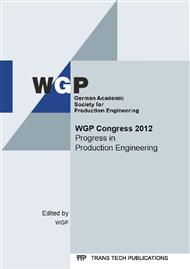p.41
p.55
p.63
p.75
p.89
p.99
p.113
p.127
p.139
CFRP-Aluminium Structures Realized by Laser Beam Joining Process
Abstract:
Modern lightweight structures containing hybrid materials allow an improvement of the weight-specific properties. However, to exploit the potential as far as possible novel joint concepts are necessary, enabling an economic structure manufacturing. The DFG-researcher group Schwarz-Silber (FOR 1224) at the University of Bremen aims to explore and develop interface structures for advanced FRP-Al compounds. Considering textile, welding and casting techniques novel joint concepts are under development, in five interdisciplinary projects. Within their work the researcher group focuses on three concepts realizing the transition structures: the usage of wires (titanium), foils (titanium) and fibres (glass fibre) as transition elements between CFRP and aluminium. Typical examples for such hybrid structures can be found in products from the aerospace industry (e.g. hull segments), the car industry (e.g. CFRP roof structures), but also in general mechanical engineering (e.g. rotor blade elements). In this paper, the joint configuration based on titanium wires and a laser beam conduction welding process will be presented. As beam source a lamp pumped Nd:YAG laser (HL4006D) was used. First specimens obtained will be discussed with respect to their properties. It will be shown that the novel approach is in principle suitable to produce load-bearing CFRP-aluminium structures. The wire concept represents a parallel arrangement of miniaturized loop connections. It is characterized by joining a CF-Ti-textile to an aluminium sheet. A carbon fibre loop is threaded through a titanium wire loop by textile technologies on one side. On the side opposite to the CF, the titanium wire loops of the CF-Ti-textile are joined to an aluminium component by welding or casting. A double-sided laser beam heat conduction welding process was applied, for both concepts. During processing, the laser beam was travels along the aluminium edge. The titanium-aluminium structure is welded in two steps. During the first step (i.e. the first weld pass) the aluminium and titanium are heated by the defocused laser beam simultaneously on both sides. An aluminium melt pool is formed, supported by the action of gravity and a certain amount of pre-heating of the titanium-wire or the titanium-foils by the laser beam and by heat conduction through the aluminium melt pool. In the second, immediately subsequent step (i.e. the second weld pass), due to a pre-heating of the materials by the first pass and an increased heat transfer between both materials, a complete wetting of the titanium structures in the joining zone is achieved.
Info:
Periodical:
Pages:
89-96
Citation:
Online since:
April 2014
Authors:
Price:
Сopyright:
© 2014 Trans Tech Publications Ltd. All Rights Reserved
Share:
Citation:


